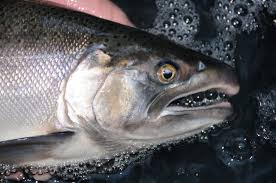THE BULK OF the vaunted summer king salmon season has come and gone with a lilywhite whimper rather than a lion’s roar, but a wave of feisty coho are set to fill the void.
According to the state Department of Fish and Wildlife, 873,000 coho are set to return from the ocean to their rivers of origin up and down Puget Sound, while a number of consistent silver runs are primed to arrive along the West End once the rain returns.
“A few guys did OK with them,” said Brian Menkal, owner of Brian’s Sporting Goods and More (360-683-1950) in Sequim, in reference to the recently closed Marine Area 9 chinook salmon season.
“I wasn’t too hot. A few guys did all right, but most people were disappointed.”
Along the Peninsula though, the second half of August is typically when the first set of silvers abandon the wild west waters of the ocean and seek the relative refuge of the Strait of Juan de Fuca and Puget Sound.
According to Menkal, “It’s just a little early,” for the silver onslaught to begin. “If we get some heavy rain, why that will bring them down.”
In the meantime, Menkal says anxious anglers have been gearing up at his shop.
“People are getting ready. They’re getting their flashers. Getting their coho killers [lures]. When it happens, it will be fast and furious.”
Menkal says the coho spend the early part of the season in deeper water offshore and then gradually work their way down the Strait and into shallower water.
In fact, anglers were reporting an “annoying” number of coho hookups during chinook season.
“They were going out by the yellow can [buoy],” said Menkal. “People were getting them when they were trying to hook chinook.”
Menkal added, “They get in quite close, actually. Later on toward September/October, they’ll come in quite close to the spit here to go up the Dungeness River.
“In another month we’ll have them by Sequim Bay and Gibson Spit, all the way to John Wayne Marina.”
A healthy run of sockeye salmon will complement the coho fishery in the Strait.
In a press release, Ryan Lothrop, recreational salmon fishery manager for the state, said, “Sockeye runs are also impressive, with some 23 million returning to the Fraser River, many swimming past our area.”
On the west end, Bob Gooding, proprietor of Olympic Sporting Goods (360-374-6330) in Forks, said the rivers are too low right now for proper coho passage.
“There’s just no water out here and it won’t be until October/November until it really fires off. Right now, it’s been pretty dry.”
Even the rain and thunderstorms of last week did little to appease Gooding or the creek beds.
“We would need that to happen for about a week straight for it to make much of a difference,” Gooding said.
Gooding says he’s heard that salt water boat anglers out off of the Strait and toward the San Juan Islands have been doing well for themselves.
“They’re doing OK there. The difference is, they’re fishing the Straits out there and you can dang near take a row boat out there.
“If you go out of La Push you are in the big pond there and a lot of people lose their courage. Out on the big pond there, if you get in trouble, you’re a long way from anywhere.
“It’s a whole different ball of wax once you get out there.
“I don’t do much ocean fishing,” laughed Gooding. “It’s all about the rivers for me.”
Despite the distance between today and the start of West End coho season, Gooding says he has anglers stopping in to gear up just like his counterpart in Sequim.
“Any more, people fish bobbers and jigs for ’em,” Gooding said. “It’s pretty easy ’cause you don’t hang up on the bottom near as much.”
“When it starts, the Sol Duc is always the best to start with. Then the Quillayute, and then the Bogachiel. The Calawah fishes too, but not as many people.”
To pilfer a line from the poet Dylan Thomas, even if you let the kings get away this summer, “Do not go gentle into that good night.”
Instead, cast a line and pray that the coho bite.
________
Jordan Nailon is a veteran outdoors writer in western Washington. He is an assistant baseball coach at Forks High School who in his spare time is a hog and vegetable farmer and beekeeper.

